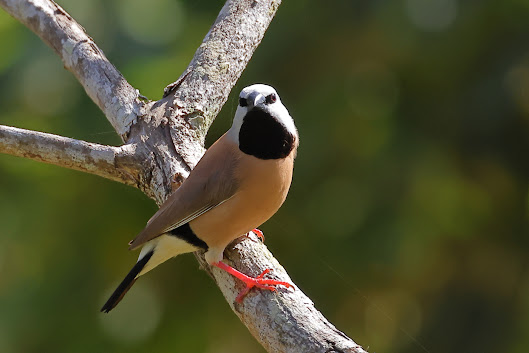
Masked Lapwing (Vanellus miles) leaves no doubt about its intention to defend four eggs in a 'nest' (the merest of depressions amid short grassy weeds) beside a sugar mill road near Ingham. Spotted the breeding pair a few days ago and drove in yesterday with camera at ready.
A few moments of fuss from the bird and plenty of pictures from the car for me and we could return to doing what comes naturally. The bird sat back on the greasy-green eggs - which look as if thinly splattered with black by a Jackson Pollock wannabe. I drove off looking for anything out of the ordinary around the mill treatment ponds. Nothing!

The photographic catches at Tyto have continued to be thin, with low overall bird numbers and reduced species present. But a few birds yesterday and today fronted up for brief flights across my horizon. They all managed to looked sharper and more attractive in life than in camera. Goes without saying, of course.

Female Black-necked Stork teased me into contemplating crawl closer (on swollen bung knee!) as it poked and prodded at the western end of the main lagoon. Luckily it eased into the air and headed east before I committed to the almost certainly fruitless effort to catch if off guard. Its presence back after the floods is, however, a favourable hint of other impending returns.

Magpie Geese have stayed in the general area, though not in large numbers. Even these big birds can be difficult to sneak up on, the more so since they've taken to the tree tops more frequently since the floods and are flightier.
One noteworthy sighting yesterday came when a pair of Shining Flycatchers darted up a creekline just as I was puzzling over the disappearance of a Common Tree Snake from a footbridge. Seems I was victim of divided attention disorder (DAD, as in you're getting old, Dad!): trying to watch three things at once led to losing all three! It did mean a rare tick, the male flycatcher being the first in five years for me at Tyto. Even females, less enamoured of the shadows, seldom venture into Tyto.
Also standing out from this week's sightings: a White-browed Crake and four large young just beginning to grow out of their black plumage. Should prove to be the first of many families begun when the floodwaters receded.
Another nesting pair also showed out. Earlier in the week watched from 40 metres away as a Comb-crested Jacana alighted directly on top of its partner in the middle of open water with just a few scraggly lotus roots and leaves forming a precarious platform. Missed the picture! Could just make out the upper outline of two eggs today. Progress will be easy enough to follow and report, near to impossible to photograph effectively.






































